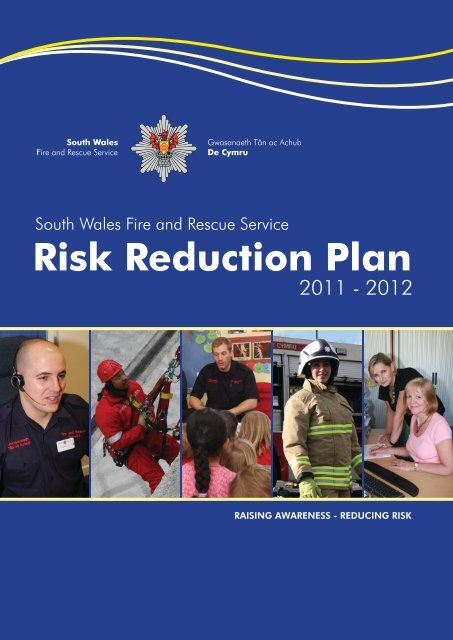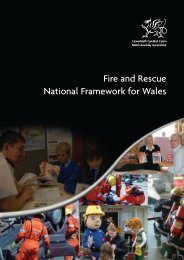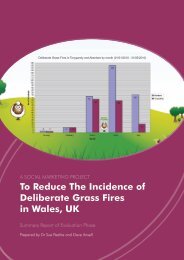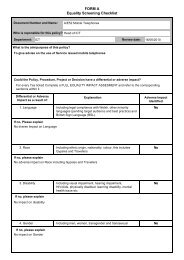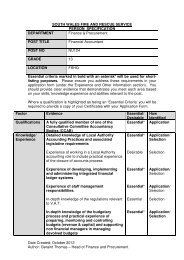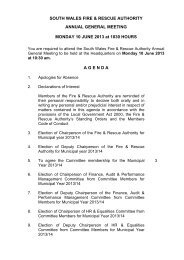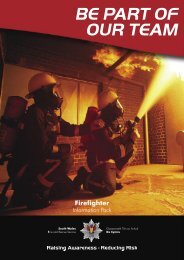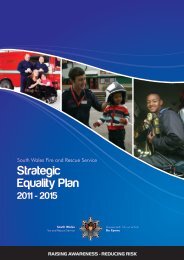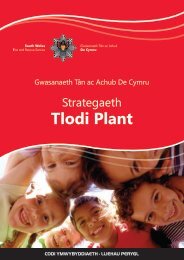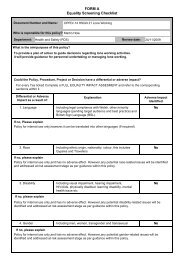Risk Reduction Plan 2011 - South Wales Fire and Rescue Service
Risk Reduction Plan 2011 - South Wales Fire and Rescue Service
Risk Reduction Plan 2011 - South Wales Fire and Rescue Service
You also want an ePaper? Increase the reach of your titles
YUMPU automatically turns print PDFs into web optimized ePapers that Google loves.
<strong>South</strong> <strong>Wales</strong> <strong>Fire</strong> <strong>and</strong> <strong>Rescue</strong> <strong>Service</strong><br />
<strong>Risk</strong> <strong>Reduction</strong> <strong>Plan</strong><br />
<strong>2011</strong> - 2012<br />
RAISING AWARENESS - REDUCING RISK<br />
1
<strong>South</strong> <strong>Wales</strong> <strong>Fire</strong> & <strong>Rescue</strong> Authority <strong>Risk</strong> <strong>Reduction</strong><br />
<strong>Plan</strong> <strong>2011</strong>-12<br />
Contents<br />
Foreword by Chairman <strong>and</strong> Chief <strong>Fire</strong> Officer<br />
Chapter 1<br />
Chapter 2<br />
Chapter 3<br />
Chapter 4<br />
Chapter 5<br />
Chapter 6<br />
What is the aim of this <strong>Plan</strong>? (p4)<br />
General <strong>Service</strong> Overview (p6)<br />
Financial Overview (p10)<br />
Improvement Objectives for <strong>2011</strong>-12 (p13)<br />
<strong>Risk</strong> <strong>Reduction</strong> <strong>Plan</strong> Projects : Scope <strong>and</strong> Deliverables (p15)<br />
How to feedback on our improvement<br />
objectives <strong>and</strong> projects (p27)<br />
RAISING AWARENESS - REDUCING RISK<br />
2
Foreword by the Chairman<br />
<strong>and</strong> Chief <strong>Fire</strong> Officer<br />
Anthony M. Ernest<br />
Chairman of <strong>South</strong> <strong>Wales</strong> <strong>Fire</strong> <strong>and</strong><br />
<strong>Rescue</strong> Authority<br />
Welcome to <strong>South</strong> <strong>Wales</strong> <strong>Fire</strong> & <strong>Rescue</strong> Authority’s<br />
Annual <strong>Risk</strong> <strong>Reduction</strong> <strong>Plan</strong>. This document will<br />
explain how we are planning to deliver the vital<br />
services we provide to our communities here in<br />
<strong>South</strong> <strong>Wales</strong>, <strong>and</strong> what our priorities are for the<br />
financial year, <strong>2011</strong>-12.<br />
As a <strong>Fire</strong> & <strong>Rescue</strong> <strong>Service</strong>, we are committed to<br />
continually improving all our activities <strong>and</strong> to drive<br />
down the frequency <strong>and</strong> severity of accidents <strong>and</strong><br />
emergencies that impact on the communities<br />
we serve. We remain committed to making our<br />
communities the safest place to live, work <strong>and</strong><br />
visit.<br />
In our <strong>Risk</strong> <strong>Reduction</strong> <strong>Plan</strong> 2010-11, we made<br />
it clear that we will need to seek new <strong>and</strong><br />
innovative ways of working in order to maintain<br />
our high st<strong>and</strong>ard of service delivery in what<br />
was a particularly volatile economic climate.<br />
The challenges that faced us then now loom<br />
even larger. This plan outlines how the <strong>Service</strong><br />
intends to respond to the unprecedented financial<br />
challenges facing the public sector within <strong>Wales</strong><br />
<strong>and</strong> seek to further improve our service.<br />
<strong>South</strong> <strong>Wales</strong> <strong>Fire</strong> & <strong>Rescue</strong> <strong>Service</strong> <strong>and</strong> its<br />
governing Authority are proud of its successes in<br />
terms of risk reduction that have been achieved<br />
since our amalgamation in 1996. The reputation<br />
of our <strong>Service</strong> has grown nationally <strong>and</strong><br />
internationally, built on a culture of continuous<br />
Andy Marles<br />
Chief <strong>Fire</strong> Officer <strong>South</strong> <strong>Wales</strong> <strong>Fire</strong> <strong>and</strong><br />
<strong>Rescue</strong> <strong>Service</strong><br />
improvement which has resulted in a safer <strong>South</strong><br />
<strong>Wales</strong>.<br />
Since the peak in our operational activity in 2002-<br />
03, the total number of fires that occur across<br />
<strong>South</strong> <strong>Wales</strong> has dropped by an amazing 49%.<br />
The tragic loss of life to fires that occur in the<br />
home has also remained remarkably low. While<br />
every fire death is obviously a tragedy in itself, the<br />
consistently low number of events resulting in the<br />
loss of life or, indeed, injury, remains significantly<br />
lower than at any time since our amalgamation.<br />
With the risk profile of <strong>South</strong> <strong>Wales</strong> changing so<br />
dramatically <strong>and</strong> the distribution of industry <strong>and</strong><br />
areas of population also changing, this is the right<br />
time to undertake a fundamental review of our<br />
<strong>Service</strong>. It is therefore our intention to undertake<br />
a number of major project reviews.<br />
In the following chapters, we will outline the<br />
projects <strong>and</strong> their scope <strong>and</strong> would welcome your<br />
responses <strong>and</strong> observations in relation to the areas<br />
where we think we need to review, redesign <strong>and</strong>,<br />
in some cases, reallocate resources to meet the<br />
challenges of the future.<br />
Thank you for taking the time to read our plan<br />
<strong>and</strong> we genuinely seek your views. All responses<br />
will, of course, receive formal recognition <strong>and</strong> the<br />
final <strong>Risk</strong> <strong>Reduction</strong> <strong>and</strong> Improvement <strong>Plan</strong> will be<br />
distributed by 31 October 2010.<br />
3
Chapter 1<br />
What is the aim of this <strong>Plan</strong>?<br />
4
This document is the <strong>South</strong> <strong>Wales</strong> <strong>Fire</strong> <strong>and</strong> <strong>Rescue</strong> Authority’s draft <strong>Risk</strong> <strong>Reduction</strong><br />
<strong>Plan</strong> for <strong>2011</strong>-2012.<br />
T<br />
he plan outlines the major strategic challenges facing the Authority in order to continue<br />
to deliver high quality services across the communities of <strong>South</strong> <strong>Wales</strong>. It builds on<br />
<strong>and</strong> complements the first <strong>Risk</strong> <strong>Reduction</strong> <strong>Plan</strong> in 2007, ‘A Safer <strong>South</strong> <strong>Wales</strong>’, <strong>and</strong> the<br />
subsequent plans published annually since then.<br />
This plan therefore should be seen as part of a suite of <strong>Risk</strong> <strong>Reduction</strong> <strong>Plan</strong>s <strong>and</strong> is intended to<br />
reflect a holistic approach to risk management. This <strong>Risk</strong> <strong>Reduction</strong> <strong>Plan</strong> will, by necessity, focus<br />
more closely on the corporate risk in relation to the unprecedented financial pressures on our<br />
service.<br />
The service remains committed to its work within communities to reduce the number <strong>and</strong> severity<br />
of fires <strong>and</strong> road traffic incidents <strong>and</strong> other emergencies. This plan, we believe, demonstrates our<br />
willingness to be outward looking, to ensure we are able to provide the services to the public, our<br />
staff <strong>and</strong> other stakeholders to continue to make <strong>South</strong> <strong>Wales</strong> a safer place.<br />
The consultation process, outlined in the <strong>Risk</strong> <strong>Reduction</strong> <strong>Plan</strong>ning Guidance 2006, issued by the<br />
Welsh Assembly Government, allows all stakeholders the opportunity to review <strong>and</strong> comment on<br />
the aims <strong>and</strong> objectives of each <strong>Fire</strong> <strong>and</strong> <strong>Rescue</strong> Authority in <strong>Wales</strong>.<br />
<strong>South</strong> <strong>Wales</strong> <strong>Fire</strong> <strong>and</strong> <strong>Rescue</strong> Authority welcome your views <strong>and</strong> assure you that each <strong>and</strong> every<br />
response will receive the highest level of attention by your Authority members <strong>and</strong> the Senior<br />
Management Team of the <strong>Fire</strong> <strong>and</strong> <strong>Rescue</strong> <strong>Service</strong>.<br />
5
6<br />
Chapter 2<br />
General <strong>Service</strong> Overview
About <strong>South</strong> <strong>Wales</strong> <strong>Fire</strong> <strong>and</strong> <strong>Rescue</strong> <strong>Service</strong><br />
Bridgend<br />
Merthyr<br />
Tydfil<br />
Rhondda<br />
Cynon Taf<br />
Vale of Glamorgan<br />
Blaenau<br />
Gwent<br />
Caerphilly<br />
Cardiff<br />
Torfaen<br />
Newport<br />
Monmouthshire<br />
<strong>South</strong> <strong>Wales</strong> <strong>Fire</strong> <strong>and</strong> <strong>Rescue</strong><br />
<strong>Service</strong> (SWFRS) covers 10 Unitary<br />
Authorities. It is one of the largest<br />
<strong>Fire</strong> <strong>and</strong> <strong>Rescue</strong> <strong>Service</strong> areas within<br />
the UK <strong>and</strong> is made up of rural,<br />
costal <strong>and</strong> urban areas<br />
Area: Nearly 300,000 hectares<br />
Population: 1.4 million<br />
Dwellings: 618,000<br />
Non-Domestic Properties: 42,000<br />
(Approximate figures)<br />
In 2009/10 approximately 44,000 emergency calls were received, resulting in approximately<br />
22,500 incidents attended within <strong>South</strong> <strong>Wales</strong>. Emergency calls are managed by the service in<br />
our <strong>Fire</strong> Control based in Pontyclun.<br />
We currently employ approximately 2000 staff, which is made up of fire fighters, control<br />
operators <strong>and</strong> support staff. We have 50 fire stations <strong>and</strong> deploy 64 front line fire engines <strong>and</strong> a<br />
range of specialist vehicles to a wide range of emergency incidents.<br />
For 2010/11, the <strong>Service</strong>’s budget is set at £72,000,000. This represents a cost of less than<br />
£1 per person, per week for the population of <strong>South</strong> <strong>Wales</strong> <strong>and</strong> we believe that represents good<br />
value for money.<br />
The management of <strong>South</strong> <strong>Wales</strong> <strong>Fire</strong> <strong>and</strong> <strong>Rescue</strong> <strong>Service</strong> is split into 5 directorates, with a <strong>South</strong> <strong>Wales</strong> <strong>Fire</strong><br />
Director responsible for each;<br />
Director<br />
Management Structure<br />
Directorate<br />
Chief <strong>Fire</strong> Officer<br />
CFO Andy Marles<br />
<strong>South</strong> <strong>Wales</strong><br />
<strong>Fire</strong> <strong>and</strong> <strong>Rescue</strong><br />
Authority<br />
Director of<br />
Communications &<br />
Culture<br />
CFO Andy Marles<br />
Director of People<br />
<strong>Service</strong>s<br />
ACO Phil Haynes<br />
Director of <strong>Service</strong><br />
Delivery<br />
DCFO Kevin Barry<br />
Director of <strong>Plan</strong>ning,<br />
Development &<br />
Support<br />
ACFO Huw Jakeway<br />
Director of Corporate<br />
Support<br />
ACO Sally Murton<br />
7
Leadership<br />
Since the 1st April 1996, <strong>South</strong> <strong>Wales</strong> <strong>Fire</strong> <strong>and</strong> <strong>Rescue</strong> <strong>Service</strong> has been the responsibility of the<br />
<strong>South</strong> <strong>Wales</strong> <strong>Fire</strong> <strong>and</strong> <strong>Rescue</strong> Authority. The <strong>Fire</strong> <strong>and</strong> <strong>Rescue</strong> Authority meets regularly throughout<br />
the year <strong>and</strong> consists of 24 elected Councillors from the ten Local Authorities that we serve.<br />
The composition of the <strong>Fire</strong> <strong>and</strong> <strong>Rescue</strong> Authority is determined by the size of the electoral<br />
representation within each Local Authority.<br />
Amongst its many roles, the <strong>Fire</strong> <strong>and</strong> <strong>Rescue</strong> Authority determines the annual budget, agrees<br />
the levels of personnel <strong>and</strong> vehicles, monitors the <strong>Service</strong>’s performance, approves the <strong>Service</strong>’s<br />
plans, policies <strong>and</strong> strategies <strong>and</strong> approves the composition of any committees, sub-committees,<br />
advisory groups <strong>and</strong> task groups.<br />
8<br />
Dragon Programme
<strong>South</strong> <strong>Wales</strong> <strong>Fire</strong> <strong>and</strong> <strong>Rescue</strong> Authority<br />
Members 2010/11<br />
The current members of the <strong>Fire</strong> <strong>and</strong> <strong>Rescue</strong> Authority, their Unitary Authority <strong>and</strong> their<br />
political party are as follows:<br />
Anthony Ernest<br />
Vale of Glamorgan<br />
Conservative<br />
Keith Hyde<br />
Cardiff<br />
Lib Dem<br />
Bob Greenl<strong>and</strong><br />
Monmouthshire<br />
Conservative<br />
Colin Mann<br />
Caerphilly<br />
Plaid<br />
Mike Bartlett<br />
Blaenau<br />
Independent<br />
Clive James<br />
Bridgend<br />
Labour<br />
David Sage<br />
Bridgend<br />
Labour<br />
Tudor Davies<br />
Caerphilly<br />
Labour<br />
Denis Bolter<br />
Caerphilly<br />
Plaid<br />
Rod McKerlich<br />
Cardiff<br />
Conservative<br />
Bill Kelloway<br />
Cardiff<br />
Lib Dem<br />
Ramesh Patel<br />
Cardiff<br />
Labour<br />
Lisa Ford<br />
Cardiff<br />
Plaid<br />
Glenn Price<br />
Merthyr Tydfil<br />
Independent<br />
Val Smith<br />
Monmouthshire<br />
Conservative<br />
William Routley<br />
Newport<br />
Conservative<br />
David H<strong>and</strong>o<br />
Newport<br />
Lib Dem<br />
Graham Stacey<br />
Rhondda Cynon Taff<br />
Labour<br />
Sylvia Jones<br />
Rhondda Cynon Taff<br />
Labour<br />
Steven Bradwick<br />
Rhondda Cynon Taff<br />
Labour<br />
John Daniel<br />
Rhondda Cynon Taff<br />
Plaid<br />
To be confirmed<br />
Torfaen<br />
Labour<br />
To be confirmed<br />
Torfaen<br />
Peoples Voice<br />
Emlyn Williams<br />
Vale of Glamorgan<br />
Conservative<br />
9
10<br />
Chapter 3<br />
Financial Overview
Financial Overview<br />
<strong>South</strong> <strong>Wales</strong> <strong>Fire</strong> <strong>and</strong> <strong>Rescue</strong> Authority’s corporate risk register identifies its allocation <strong>and</strong> use of<br />
resources in the current financial climate as the highest risk the Authority faces in being able to<br />
maintain service delivery to the public.<br />
As one of the methods utilised by the <strong>Fire</strong> <strong>and</strong> <strong>Rescue</strong> Authority to address this risk, it has recently<br />
adopted its first Medium Term Financial <strong>Plan</strong> for the period 2010-14. It is produced in a period<br />
of financial uncertainty <strong>and</strong> turbulence, but against an assured background that funding for<br />
public services will be under severe pressure in the years to come. The Medium Term Financial<br />
<strong>Plan</strong> is one of four key corporate plans, one of which is the <strong>Risk</strong> <strong>Reduction</strong> <strong>Plan</strong>.<br />
The Medium Term Financial <strong>Plan</strong> has been designed to support the <strong>Fire</strong> <strong>and</strong> <strong>Rescue</strong> Authority’s<br />
identified priorities in the <strong>Risk</strong> <strong>Reduction</strong> <strong>Plan</strong>. This is done within the context of the current<br />
estimates of budget reductions that the Authority will face over the next 3 years. In summary,<br />
these are as follows:<br />
11
The Financial <strong>Plan</strong> also makes some planning <strong>and</strong> budget assumptions on the financial<br />
implications to the organisation of the priorities in this <strong>Risk</strong> <strong>Reduction</strong> <strong>Plan</strong>. The results of these<br />
are that without further action, the <strong>Service</strong> potentially faces considerable financial shortfalls in its<br />
budget over the next few years. This is illustrated in the graph below.<br />
This <strong>Risk</strong> <strong>Reduction</strong> <strong>Plan</strong> takes account of these budget implications in setting its priorities for<br />
the year ahead. As a result, if the proposals within this <strong>Plan</strong> are successfully implemented, then<br />
in addition to maintaining or improving our service to the public, the budget shortfall facing the<br />
Authority will also be reduced as illustrated below.<br />
Gap<br />
12
13<br />
Chapter 4<br />
Improvement Objectives<br />
for <strong>2011</strong>-12
Improvement Objectives <strong>2011</strong>/12<br />
Every year we set ourselves improvement objectives which identify the areas where we<br />
want to concentrate our efforts in the forthcoming year in order to help to deliver our<br />
vision ‘to make our communities the safest places to live, work <strong>and</strong> visit’.<br />
The specific actions we will take to deliver these improvement objectives are included in<br />
our directorate level plans which are available to view on our website at:<br />
www.southwales-fire.gov.uk<br />
Progress against our annual improvement objectives are reported in our annual<br />
Improvement <strong>Plan</strong> which is published in October of each year <strong>and</strong> is also available on<br />
our website.<br />
Our improvement objectives for <strong>2011</strong>/12 are:-<br />
Theme<br />
Objective<br />
Responsible Director<br />
Our Communities<br />
To reduce deaths <strong>and</strong> injuries from fires <strong>and</strong> road traffic collisions.<br />
DCFO <strong>Service</strong> Delivery<br />
Theme<br />
Objective<br />
Responsible Director<br />
Our People<br />
To continue to develop a responsive <strong>and</strong> creative workforce<br />
who practice our values.<br />
Director People <strong>Service</strong>s<br />
Theme<br />
Objective<br />
Responsible Director<br />
Our Resources<br />
To ensure that our resources <strong>and</strong> assets are utilised effectively<br />
to support service delivery.<br />
Director Corporate Support<br />
Theme<br />
Objective<br />
Responsible Director<br />
Our Organisation<br />
To improve internal service delivery ensuring the most<br />
effective use of both financial <strong>and</strong> people resources.<br />
Director Corporate Support<br />
Theme<br />
Objective<br />
Responsible Director<br />
Sustainability<br />
To promote sustainable local communities through our<br />
activities.<br />
Director CFO<br />
14
15<br />
Chapter 5<br />
<strong>Risk</strong> <strong>Reduction</strong> <strong>Plan</strong> Projects :<br />
Scope <strong>and</strong> Deliverables
Project Brief for Implementation in <strong>2011</strong>-2012<br />
In this section of the plan we detail the major projects <strong>and</strong> their<br />
intended outcomes.<br />
While each project has an individual brief, there are undoubted<br />
inter-dependencies.<br />
The projects are not necessarily presented in order of priority<br />
<strong>and</strong> in all cases will run concurrently in order to allow for<br />
implementation in year <strong>2011</strong>-12.<br />
Projects<br />
1. Self Rostering Stations (17)<br />
2. <strong>Fire</strong> Cover (19)<br />
3. Second Pumping Appliances (20)<br />
4. Special Appliances (21)<br />
5. Provision of Operational Tactical Managers (22)<br />
6. Middle Managers <strong>and</strong> Day Duty Uniformed Structure (23)<br />
7. Organisational Structures (24)<br />
8. Overtime & Out Of Hours Allowances (25)<br />
9. I.C.T Systems (26)<br />
16
Self Rostering<br />
Brief<br />
The <strong>Fire</strong> <strong>and</strong> <strong>Rescue</strong> Authority has<br />
identified future restrictions on the<br />
revenue budget. Therefore maximising<br />
the effective use of resources is our<br />
current <strong>and</strong> future objective.<br />
The Self Rostering project aims to<br />
deliver an effective <strong>and</strong> efficient level<br />
of service to <strong>South</strong> <strong>Wales</strong>’ communities<br />
where an existing fire station<br />
experiences low levels of activity against<br />
a backdrop of low risk, such as Penarth,<br />
New Inn <strong>and</strong> Maesteg.<br />
Research has indicated changing shift<br />
patterns <strong>and</strong> staffing levels can achieve<br />
a reduction in staff costs without any<br />
detriment to the level of fire cover to the<br />
community.<br />
The proposed changes include the<br />
following benefits.<br />
• There is potential to save in the<br />
region of £500k per station per<br />
annum.<br />
• The introduction of Self-rostering as<br />
an alternative crewing arrangement<br />
will maintain the current st<strong>and</strong>ards<br />
of emergency response to the<br />
communities of Penarth, New Inn<br />
<strong>and</strong> Maesteg<br />
• The proposed new shift pattern<br />
provides the staff with a greater<br />
level of flexibility regarding the<br />
shifts they wish to work.<br />
• The proposed new shift pattern<br />
would attract financial benefits<br />
to the staff through additional<br />
allowances<br />
17<br />
New PPE
Self Rostering<br />
continued<br />
Deliverables:<br />
The project team will<br />
• Take the results of the feasibility/scoping studies to the Programme Board<br />
• Take the accommodation options, outline design <strong>and</strong> indicative costs for the proposed<br />
stations to the Programme Board<br />
• In collaboration with the relevant senior managers in <strong>Service</strong> Delivery directorate <strong>and</strong><br />
consultants agree, the design requirements for the accommodation sites<br />
• In collaboration with relevant consultants manage the building alterations for the<br />
accommodation sites<br />
• Procure <strong>and</strong> install the furniture <strong>and</strong> equipment in the accommodation sites<br />
• In collaboration with the relevant senior managers in People <strong>Service</strong>s <strong>and</strong> <strong>Service</strong><br />
Delivery directorates, draft relevant protocols such as mobilisation times <strong>and</strong> notice<br />
periods to come off shift pattern, Conditions of <strong>Service</strong> for the proposed shift pattern<br />
<strong>and</strong> criteria for filling posts in the Self Rostering stations<br />
• In collaboration with the relevant senior managers in <strong>Service</strong> Delivery establish <strong>and</strong><br />
manage the internal <strong>and</strong> external communications strategy with all stakeholders<br />
• In collaboration with the Head of Business Support set up facilities management related<br />
contracts for accommodation sites<br />
• In collaboration with the Head of Information Communication Technology to arrange<br />
for additional ICT equipment <strong>and</strong> broadb<strong>and</strong> access.<br />
• To identify <strong>and</strong> report potential <strong>and</strong> actual efficiency savings achieved by the project.<br />
• In collaboration with the relevant senior managers in <strong>Service</strong> Delivery establish <strong>and</strong><br />
manage the internal <strong>and</strong> external communications strategy with all stakeholders<br />
18
<strong>Fire</strong> Cover Review<br />
Brief<br />
The <strong>Fire</strong> <strong>and</strong> <strong>Rescue</strong> Authority has identified a changing pattern<br />
of operational dem<strong>and</strong>. Therefore, a review of the location<br />
of fire stations has been identified as a potential for efficiency<br />
savings while also maintaining a high level of service delivery<br />
to the public.<br />
The existing location of the <strong>Service</strong>’s fire <strong>and</strong> rescue stations<br />
was determined by the needs of the three former Brigades.<br />
Furthermore, since 1996 there has been a significant reduction<br />
in the call rates <strong>and</strong> workloads of some stations.<br />
The objective is to carry out a high level review of the<br />
contribution to public <strong>and</strong> firefighter safety made by each<br />
station <strong>and</strong> to identify those areas where more in-depth analysis<br />
should be conducted.<br />
The benefits of the review include:<br />
• Providing The <strong>Fire</strong> <strong>and</strong> <strong>Rescue</strong> Authority with evidence to<br />
enable them to determine if the location of existing fire<br />
<strong>and</strong> rescue stations is suitable to meet the current <strong>and</strong><br />
future dem<strong>and</strong>s likely to be faced by the <strong>Service</strong>.<br />
• Identify opportunities to realise efficiency savings that may<br />
arise from any proposed changes whilst maintaining our<br />
commitment to our communities.<br />
Deliverables:<br />
The project team <strong>and</strong><br />
other key personnel are<br />
responsible for delivering<br />
an evidence based report<br />
to the <strong>Fire</strong> <strong>and</strong> <strong>Rescue</strong><br />
Authority detailing;<br />
• The contribution <strong>and</strong><br />
cost-effectiveness of<br />
each existing station.<br />
• The options for the<br />
future locations<br />
<strong>and</strong> crewing<br />
arrangements of<br />
stations including<br />
the impact of any<br />
proposal.<br />
• Identify those<br />
changes that can be<br />
made in the short to<br />
medium term with<br />
little or no capital<br />
investment.<br />
• Identify those<br />
changes that can be<br />
made in the medium<br />
to long term that may<br />
also require capital<br />
investment.<br />
• A migration plan for<br />
each proposal.<br />
19
Review of Second Pumping Appliances<br />
Brief<br />
A review of all second pumping appliances across the <strong>Service</strong><br />
has been identified as a potential efficiency saving. Maintaining<br />
the high level of service delivery to the public <strong>and</strong> fire-fighter<br />
safety continue to be our priority.<br />
Currently the <strong>Service</strong> has 14 second pumping appliances which<br />
are crewed using a range of duty systems.<br />
The objective of the project is to explore the effectiveness <strong>and</strong><br />
future need of each second pumping appliance including the<br />
location, incident data, call rates <strong>and</strong> crewing arrangements.<br />
The benefits of the review include<br />
• The assurance the appliances are based at the most<br />
effective locations based on topography <strong>and</strong> road links<br />
• The number of second pumping appliance matches the<br />
risk <strong>and</strong> incident profile in a given area<br />
• Maximising the effective use of appropriate crewing<br />
arrangements<br />
• Opportunity to identify <strong>and</strong> realise efficiency savings<br />
that may arise from any changes to second pumping<br />
appliances<br />
Deliverables:<br />
The project team <strong>and</strong><br />
other key personnel are<br />
responsible for delivering<br />
an evidence based report<br />
to the <strong>Fire</strong> <strong>and</strong> <strong>Rescue</strong><br />
Authority detailing;<br />
• the contribution <strong>and</strong><br />
cost-effectiveness<br />
of existing second<br />
pumping appliance,<br />
• the options for the<br />
future disposition <strong>and</strong><br />
crewing arrangements<br />
of each second<br />
pumping appliance<br />
including the impact<br />
of any changes<br />
• the associated costs<br />
<strong>and</strong> anticipated<br />
efficiency savings for<br />
each option<br />
• the proposed<br />
migration plan for<br />
each option.<br />
20<br />
Maesteg FIre Station
Review of Special Appliances<br />
Brief<br />
The <strong>Fire</strong> <strong>and</strong> <strong>Rescue</strong> Authority has identified a changing pattern<br />
of operational dem<strong>and</strong>. Therefore, a review of all special<br />
appliances across the <strong>Service</strong> has been identified as a potential<br />
efficiency saving. Maintaining the high level of service delivery<br />
to the public <strong>and</strong> fire-fighter safety continue to be our priority.<br />
Currently, the <strong>Service</strong> has a wide range of special appliances<br />
which are crewed using a range of duty systems.<br />
The objective of the project is to explore the effectiveness of<br />
each special appliance including the location, incident data,<br />
call rates <strong>and</strong> crewing arrangements.<br />
The benefits of the review include<br />
• The number <strong>and</strong> type of special appliance matches the<br />
risk <strong>and</strong> incident profile in a given area<br />
• The assurance that appliances are based at the most<br />
effective locations based on topography, road links <strong>and</strong><br />
the built environment<br />
• Maximising the effective use of appropriate crewing<br />
arrangements <strong>and</strong> vehicle design<br />
Deliverables:<br />
The project team <strong>and</strong><br />
other key personnel are<br />
responsible for delivering<br />
an evidence based report<br />
to the <strong>Fire</strong> <strong>and</strong> <strong>Rescue</strong><br />
Authority maintaining<br />
a safe system of work,<br />
detailing;<br />
• the contribution <strong>and</strong><br />
cost-effectiveness of<br />
each existing special<br />
appliance,<br />
• options for<br />
rationalising the types<br />
of special appliances<br />
in service.<br />
• the options for the<br />
future disposition<br />
<strong>and</strong> crewing<br />
arrangements of each<br />
proposed special<br />
appliance including<br />
the impact of any<br />
changes<br />
• the associated costs<br />
(including an outline<br />
of the associated<br />
staff relocation <strong>and</strong><br />
additional training<br />
costs) <strong>and</strong> anticipated<br />
efficiency savings for<br />
each option.<br />
• The impact, if any, on<br />
our building stock.<br />
• A migration plan for<br />
each option.<br />
Hydrolic Platform<br />
21
Review of Provision of Operational Tactical Managers<br />
Brief<br />
The <strong>Fire</strong> <strong>and</strong> <strong>Rescue</strong> Authority<br />
has requested a review of<br />
the provision of operational<br />
tactical managers. Currently,<br />
there are 68 tactical managers<br />
made up of 4 rota groups<br />
each with 6 Group Managers<br />
<strong>and</strong> 11 Sstation Managers.<br />
The purpose of the project<br />
is to review our operational<br />
response at tactical manager<br />
level including;<br />
• Ensuring efficient <strong>and</strong><br />
effective use of resources.<br />
• The provision of<br />
adequate numbers of<br />
tactical managers with<br />
the relevant level of<br />
comm<strong>and</strong> competencies<br />
to meet our operational<br />
planning assumption.<br />
• The provision of specialist<br />
skill sets at operational<br />
incidents to enable the<br />
incident comm<strong>and</strong>er<br />
to bring the incident to<br />
a safe <strong>and</strong> satisfactory<br />
conclusion.<br />
• Attendance times of<br />
appropriate levels of<br />
comm<strong>and</strong> <strong>and</strong> specialist<br />
skill sets<br />
The research will take<br />
cognisance of the outcomes<br />
of any recent or impending<br />
reports/audits produced by<br />
government departments, the<br />
Chief <strong>Fire</strong> Officers’ Association<br />
or the Health & Safety Executive<br />
relating to firefighter safety or<br />
comm<strong>and</strong> <strong>and</strong> control.<br />
The objective of the project<br />
is to produce a report which<br />
identifies a range of options to<br />
enable the <strong>Service</strong> to provide<br />
an appropriate structure <strong>and</strong><br />
duty system which result in<br />
operational tactical officers<br />
with appropriate comm<strong>and</strong><br />
<strong>and</strong> specialist skills to bring<br />
incidents to a safe <strong>and</strong><br />
satisfactory conclusion.<br />
Whilst the project focuses on<br />
the provision of an appropriate<br />
number of competent<br />
operational tactical managers,<br />
it should take account of other<br />
projects reviewing:<br />
• incident comm<strong>and</strong> levels<br />
• organisational structures<br />
• operational <strong>and</strong> nonoperational<br />
middle<br />
manager structures<br />
This project will include a<br />
review of incident profiles<br />
<strong>and</strong> changes in the level of<br />
operational tactical manager<br />
for comm<strong>and</strong> <strong>and</strong> control<br />
<strong>and</strong> specialist functions such<br />
as detection, identification<br />
<strong>and</strong> monitoring of Hazardous<br />
materials, safety, fire safety,<br />
comm<strong>and</strong> support <strong>and</strong> fire<br />
investigation purposes through<br />
attendance at an incident or<br />
tactical support.<br />
The Benefit of this review is<br />
to ensure that the appropriate<br />
number of managers with<br />
the relevant comm<strong>and</strong><br />
competencies <strong>and</strong>/or specialist<br />
skills, arrive at an incident within<br />
a suitable period to ensure<br />
that it is brought to a safe <strong>and</strong><br />
satisfactory conclusion.<br />
.<br />
<strong>Fire</strong> Safety Officers<br />
Deliverables:<br />
A report outlining a<br />
range of options <strong>and</strong><br />
recommendations for<br />
changing the existing<br />
provision of operational<br />
tactical managers.<br />
Each option will include<br />
estimated costings,<br />
potential impacts<br />
on organisational<br />
development plan,<br />
operational tactical<br />
management<br />
development plan,<br />
proposed migration<br />
plan <strong>and</strong> an indicative<br />
timetable for<br />
implementation.<br />
22
Review of Middle Management <strong>and</strong><br />
Day Duty Uniformed Structures<br />
Brief<br />
The <strong>Fire</strong> <strong>and</strong> <strong>Rescue</strong> Authority has requested a review of<br />
organisational structures to ensure they are designed to<br />
deliver efficient <strong>and</strong> effective services to the public. A review<br />
of operational <strong>and</strong> non-operational middle manager roles is<br />
required to establish if efficiency savings can be achieved.<br />
Whilst it is fully appreciated that the roles of middle managers<br />
within the organisation is an essential element to successful<br />
service delivery, the potential improvements in this area need to<br />
be explored <strong>and</strong> if identified they must be realised. The review<br />
will have the improvement of service delivery to the public <strong>and</strong><br />
our other stakeholders at the forefront at all times.<br />
The objective of the research stage of this project is to produce<br />
a report which:<br />
• establishes the efficiency <strong>and</strong> effectiveness of middle<br />
managers across the organisation<br />
• aligns operations <strong>and</strong> non-operations responsibilities at<br />
middle manager level<br />
• identifies opportunities to realise efficiency savings that<br />
may arise from any changes to middle management<br />
structures.<br />
Deliverables:<br />
The project team <strong>and</strong><br />
other key personnel are<br />
responsible for delivering<br />
the following<br />
• Producing a<br />
report to <strong>Fire</strong> <strong>and</strong><br />
<strong>Rescue</strong> Authority<br />
on the options <strong>and</strong><br />
recommendations<br />
for improving the<br />
effectiveness <strong>and</strong><br />
efficiency of the<br />
operational <strong>and</strong> nonoperational<br />
middle<br />
managers.<br />
• The options should<br />
focus on empowering<br />
middle managers<br />
to enable them<br />
to carry out their<br />
respective roles<br />
<strong>and</strong> responsibilities<br />
whilst ensuring line<br />
management support<br />
is provided<br />
• Each option will<br />
include estimated<br />
costings, anticipated<br />
efficiency savings,<br />
proposed migration<br />
plan <strong>and</strong> an<br />
indicative timetable<br />
for implementation.<br />
23
Review of Structures <strong>and</strong> Business Processes<br />
Brief<br />
The <strong>Fire</strong> <strong>and</strong> <strong>Rescue</strong> Authority has requested a review of<br />
organisational structures to ensure they are designed to<br />
deliver efficient <strong>and</strong> effective support services to the public. In<br />
addition, anticipated restrictions on the revenue budget such<br />
as changes in funding arrangements <strong>and</strong> the economic climate<br />
should focus the project activities towards the provision of core<br />
business activities <strong>and</strong> legislative requirements.<br />
The review of structures is also dependent on the outcome of<br />
a number of other projects including the impact of potential<br />
changes to ICT systems <strong>and</strong> review of middle management<br />
structures <strong>and</strong> operational tactical managers’ duty system.<br />
In order for this project to be a success Principal Officers<br />
<strong>and</strong> Heads of <strong>Service</strong> should provide a clear communication<br />
strategy to their teams. This will enable full engagement with<br />
staff.<br />
The aim of the review of structures is to capitalise on the<br />
efficiency savings identified through improving business<br />
processes, changes to funding <strong>and</strong> potential collaboration<br />
across <strong>Wales</strong> <strong>and</strong> other Unitary Authorities.<br />
The benefits of the review include<br />
• Improved organisational efficiency in support functions by<br />
linking structures to business processes<br />
• Opportunity to identify <strong>and</strong> realise efficiency savings that<br />
may arise from any changes to organisational structures.<br />
Deliverables:<br />
A report summarising<br />
the range of options<br />
<strong>and</strong> recommendations<br />
for changing existing<br />
structures.<br />
Each option will include<br />
estimated costings,<br />
anticipated efficiency<br />
savings, proposed<br />
migration plan <strong>and</strong> an<br />
indicative timetable for<br />
implementation.<br />
24
Review of Overtime <strong>and</strong> Out of Hours Allowances<br />
Brief<br />
The <strong>Fire</strong> <strong>and</strong> <strong>Rescue</strong> Authority has identified future restrictions<br />
on the revenue budget. Therefore, ensuring the overtime<br />
<strong>and</strong> salary budgets are used effectively <strong>and</strong> efficiently is a<br />
key objective. It is accepted that some overtime by stationbased<br />
staff is unavoidable as it is pre-arranged such as public<br />
holidays <strong>and</strong> casual overtime as in the case of incidents<br />
occurring during change of shifts.<br />
The aim of the review is to identify ways of managing activities<br />
differently ensuring that overtime <strong>and</strong> out of hours allowances<br />
are applied consistently <strong>and</strong> only when necessary.<br />
The benefits of the review are<br />
• Effective use of resources through increasing flexible ways<br />
of working<br />
• Potential reduction in overtime <strong>and</strong> salary budgets<br />
• Increased productivity<br />
Deliverables:<br />
The project team <strong>and</strong><br />
other key personnel are<br />
responsible for delivering<br />
an evidence based report<br />
to the <strong>Fire</strong> <strong>and</strong> <strong>Rescue</strong><br />
Authority detailing;<br />
• the current extent<br />
<strong>and</strong> cost of paying<br />
overtime <strong>and</strong> out of<br />
hours allowances<br />
• a range of<br />
options <strong>and</strong><br />
recommendations<br />
for reducing the<br />
overtime <strong>and</strong> out of<br />
hours allowances<br />
budget including any<br />
new flexible working<br />
arrangements <strong>and</strong><br />
criteria for accruing<br />
compensatory leave<br />
• how the<br />
organisational needs<br />
will be met.<br />
• each option will<br />
include estimated<br />
costings, anticipated<br />
efficiency savings,<br />
proposed migration<br />
plan <strong>and</strong> an<br />
indicative timetable<br />
for implementation<br />
25
Review of Major ICT Systems<br />
Brief<br />
Currently each department has its own computer system<br />
optimised for the particular ways that the department does<br />
its work which results in multiple data entry, inefficient use of<br />
the data <strong>and</strong> resources. It is intended to review the core ICT<br />
systems including Human Resources, Payroll, Finance, Asset<br />
Management, Procurement, Stores <strong>and</strong> Fleet with the intention<br />
to procure an Enterprise Resource <strong>Plan</strong>ning (ERP) system to<br />
integrate all departments <strong>and</strong> functions across the <strong>Service</strong> onto<br />
a single computer system that can serve all those different<br />
departments’ particular needs. An ERP system will combine<br />
them all together into a single, integrated software program<br />
that runs off a single database so that the various departments<br />
can more easily share information <strong>and</strong> communicate with each<br />
other.<br />
A report outlining options<br />
<strong>and</strong> recommendations<br />
for integrating the<br />
services ICT sytems which<br />
will result in:<br />
Deliverables:<br />
• Having more efficient<br />
business processes<br />
• A common<br />
infrastructure with<br />
common st<strong>and</strong>ards <strong>and</strong><br />
capabilities<br />
• A Reduced<br />
maintenance burden<br />
• A Review of planned<br />
<strong>and</strong> ongoing<br />
collaborative projects<br />
in ICT by other public<br />
sector providers<br />
• A Project plan for<br />
implementation to<br />
include business case,<br />
financial modelling <strong>and</strong><br />
timelime.<br />
26
Chapter 6<br />
How to feedback on<br />
our objectives <strong>and</strong> projects<br />
27
◦ ◦ ◦<br />
<br />
<br />
<br />
<br />
<br />
<br />
<br />
<br />
<br />
28
◦ ◦ ◦ ◦ ◦ ◦<br />
◦ ◦ ◦ ◦ ◦ ◦<br />
◦ ◦ ◦ ◦ ◦ ◦<br />
◦ ◦ ◦ ◦ ◦ ◦<br />
◦ ◦ ◦ ◦ ◦ ◦<br />
29
◦ ◦ ◦ ◦ ◦ ◦<br />
◦ ◦ ◦ ◦ ◦ ◦<br />
<br />
<br />
◦ ◦ ◦ ◦ ◦ ◦<br />
◦ ◦ ◦ ◦ ◦ ◦<br />
<br />
<br />
◦ ◦ ◦ ◦ ◦ ◦<br />
<br />
<br />
◦ ◦ ◦ ◦ ◦ ◦<br />
<br />
<br />
◦ ◦ ◦ ◦ ◦ ◦<br />
<br />
<br />
◦ ◦ ◦ ◦ ◦ ◦<br />
◦ ◦ ◦ ◦ ◦ ◦<br />
30
31
This document is available in alternative formats <strong>and</strong> languages<br />
including Braille, audio, British Sign Language <strong>and</strong> Easy Read.<br />
If you would like any information in an alternative<br />
format please let us know.<br />
<strong>South</strong> <strong>Wales</strong> <strong>Fire</strong> & <strong>Rescue</strong> <strong>Service</strong> HQ,<br />
Forest View Business Park, Llantristant, CF72 8LX<br />
www.southwales-fire.gov.uk<br />
Telephone - 01443 232000


